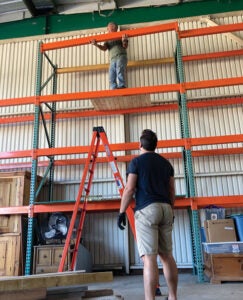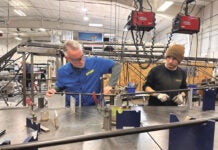
By introduction to his Civilisation television series, Sir Kenneth Clark made a case for the most trustworthy window on a society being its art, as in painting and architecture. Given that view, I must admit a historian considering my hangar in its architecture, decoration and contents would, perforce, be required to think uncharitably regarding my epoch.
But it is true. Hangars are perhaps the most important yet unheralded aspect of aviation. Tin sheds in the main, they are little considered and only casually kept by most of even our enthusiast set. Yet anyone living in the mechanical age and given custody of any piece of machinery either knows or will soon learn the most important invention yet in the preservation of all the time and treasure poured into an air buggy is the roof. The most stalwart bulwark against the second law of thermodynamics yet invented, the roof, along with its wall and floor appendages, is the thing that most keeps our machinery in order. Doubt that and I invite you to leave your airplane outside for two years and see what happens.
In fact, it’s an experiment I’ve run many times, thankfully not with aircraft, but with cars, trailers, tractors and the like. Even in my supposedly benign climate of Southern California—a duplicitous construct enacted by a series of basely motivated chambers of commerce and associated real estate types—any machine I’ve left outside has died well before its time in a silent yet surprisingly rapid decay marked by faded paint, existential rust and a general corrosion that pierces even the remotest depths of the engine block or chassis recesses and threatens to exit through the wallet with such violence the careless caretaker concedes defeat and the machine is lost.
Thus educated, I’ve resolved not to own anything nice unless it has its own roof, and so I’ve come to appreciate even the humblest of hangars. It’s also caused me to reflect on what I choose to keep in my own hangar, although I’ll admit that besides showing an industriousness in consolidation, my choices are wholly mundane and can veer dangerously past rational thanks to generally lax discipline and renting a rather large hangar capable of holding an inordinate volume of detritus in the first place.
Which leads back to Clark’s observation that the what and how of a hangar reflects upon its caretaker’s priorities, and my continuation of the theme in noting such priorities change along with one’s way in life. And so to the present, where my hangar mate, being presented with a somewhat unexpected challenge in his life far from the hangar, has need to store much more than planned in our tin shed, at least for awhile.
So like a general planning for the last war where the goal was to store as much stuff as possible, rather than broom out with extreme prejudice and save only the survivors, I’ve elected to follow my partner’s need, meaning together we purchased more than a few linear feet of pallet racking. Given the near-20-foot interior height of our hangar, there is some efficiency in 16-foot-high shelving, after all.
Naturally, this means we had to purchase the pallet racking (used, from the local metal yard), transport it (all hail the dually and double-axle flatbed), wash it and erect it. Once that bit of weight lifting was accomplished, it was necessary to deck the racking as it came bereft of said option, and boy did we get a quick education on the price of 4×8 sheet and 2×4 wall studs, not to mention 5 pounds of wood screws was $26. All in keeping with our $5.25 per gallon diesel fuel, I suppose.
Treasure or Trash?
Of course, the real education is in weeding through the darker corners of the hangar while making room for the new racking. While I’ll further the conceit my memory remains usefully functional, I’ll also admit digging through the gritty piles was more voyage of rediscovery than expected, and it was illuminating seeing what’s been taking up so much room for so long. A good example was a medium-size cardboard box, open at the top and sprouting a bouquet of rusty pipes. It took a second to remember this was the mock-up set of headers made from mild steel from the local muffler shop when developing the exhaust system for the new Starduster engine back in 2010. There is a couple of weeks of cutting, fitting, tack welding and general, “Where in the Sam Hill am I going to run this pipe?” noodling enshrined in that tangle of rusty tubing, so it isn’t like I don’t have any investment here (never mind I’ve been enjoying the actual 521 stainless headers on the Starduster for the past 11 years). I mean, who knows when you might need to mock up another set of headers—experience would say once every 55 years—and that was handsome new pipe when I bought it, so you just aren’t going to toss it in the dumpster. On the other hand, I’ll never need it again so it’ll be a good thing to put it 16 feet in the air on the new shelving’s upper deck. It’s kind of difficult to lift stuff that high anyway, so it’s strictly long-term storage up there in the nosebleed section.
I also came across three small-block Ford V-8s at the bottom of the biggest pile. True, I had not forgotten they were there, but seeing them again was something akin to anticipating your 20th high school reunion because she was going to be there, and then seeing her. Not quite the same as the last time you laid eyes on each other and maybe a goad to moving on to new adventures. In the reunion’s case that’s as easy as leaving the party, but with 1500 pounds of cast iron there’s a bit more inertia to overcome.
Then there are those shelves full of used screws and washers. There was a time when perhaps you didn’t have a ready supply of new hardware to replace the stuff that keeps falling off the plane, but you’ve been sticking close to work for a while now and can afford a baggie of 50 AN526 screws these days. Do you really just toss out the old stuff? I mean, like just turn all those cans upside down into the trash and watch hundreds of those carefully hoarded treasures tinkle to the bottom of the bin? Can I really do that?
Such is the stuff that tries my soul, a spirit born of depression-era parents and honed through the disco era when a good home loan was just 12% interest. My plans no longer include rusty tubing or used sheet metal screws with gnarly Phillips heads, yet that stuff holds on like so much engineering algae. Even I don’t think I’m going through three V-8s in whatever time remains for me, but if I take that one off the pallet and put it on one of those rolling stands it will take up a lot less room under the bottom shelf. The stands are only $80 online…













